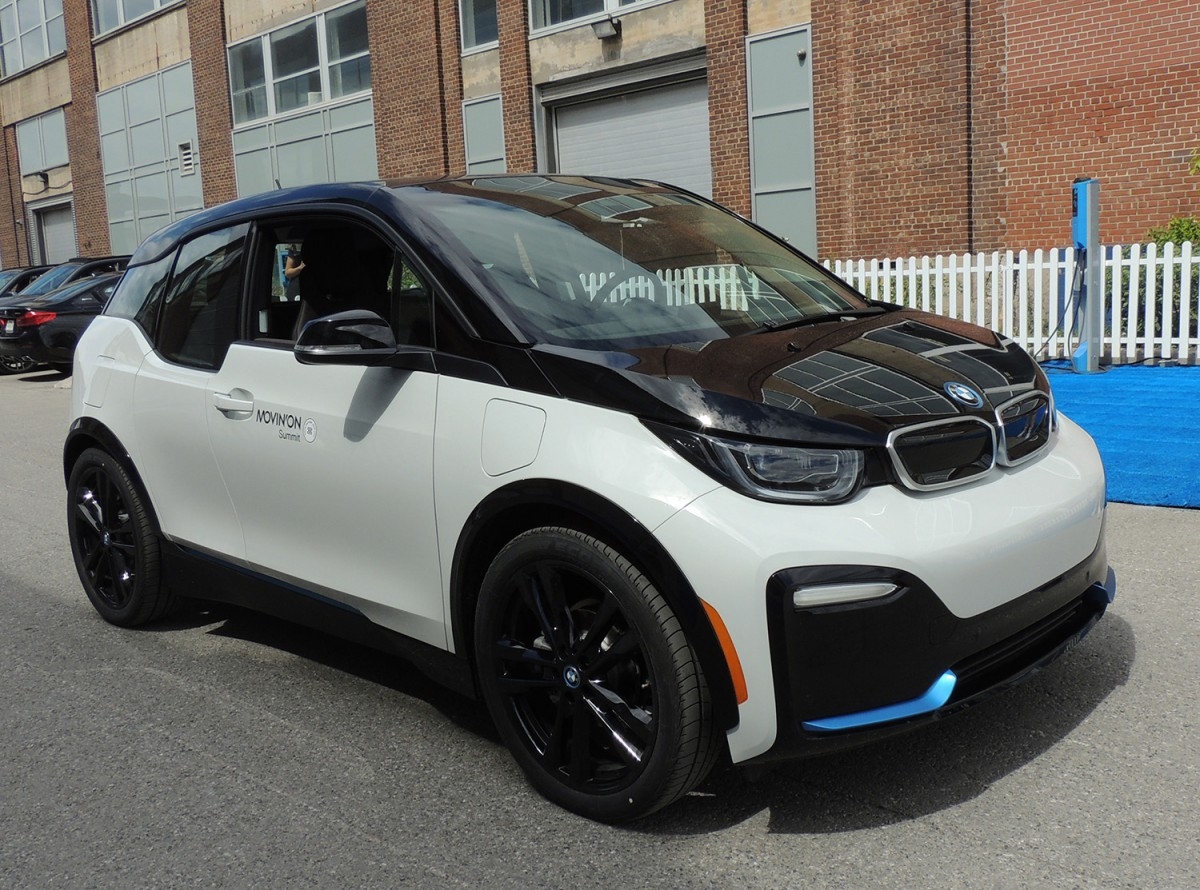
Movin’ On Summit offers glimpse of future mobility
A selection of EVs was on display at the Summit. All were available for a test drive – like this BMW i3. (Credit: Neil Moore)
Michelin’s Movin’ On Summit was an eye opener for this long-time petrolhead. I’ve always liked cars, especially those that go fast, but I’m gaining an appreciation for those options that, until now, I’ve shunned. Like ride sharing, biking, and (ugh!) transit.
All have gotten smarter with the rise of electric drivetrains, artificial intelligence (AI), and digital platforms. Making my SUV – and its driver – seem a bit old-school.
Indeed, the single occupancy vehicle is quickly falling from favour, a point that was hammered home during my two days at this global event in Montreal.

That’s not to say I’ll be swapping my gas burner for an electric right away, or ditching it for the bus. But having listened to Summit speakers from around the world, I’ve discovered that arriving at your destination, without killing polar bears, doesn’t have to be painful.
Right from the starting line, progressive ideas and opinions flowed at Movin’ On – all of which were a refreshing change to the daily blather about pipelines and “clean coal.” Expert speakers from Europe, Asia, South and Central America all delivered valuable insights on how the rest of the world is dealing with issues like climate change, congestion, and the high costs of fuel.
“We are living in a time of unprecedented change in the way people and goods are moving around,” said Mary Krass, moderator of an early panel discussion on Rethinking Urban Mobility. She referred to new forms of on-demand services such as transport network trucking, shared taxis, autonomous vehicles, and even electric scooters. “All of this offers a compelling set of new mobility options for urban areas.”
Many of the experts cited examples from overseas, but a more local project was presented by Thales, a global high-tech firm with 80,000 employees in 68 countries. The company may be more “behind the scenes” in terms of mobility solutions, but their signalling system for Ottawa’s LRT is helping take rush hour bus trips off the road, and putting them on rails.
“Thales was proud to showcase our sustainable transportation technology solutions, including exciting projects under development right here in Ontario, in partnership with the Canadian, Quebec, and Ontario governments,” said Walter Kinio, VP Research and Innovation. “This includes projects such as 5G and next-generation autonomous train positioning, obstacle detection and tracking.”
Smarter trains are a part of any system that puts riders first, giving them an incentive to swap their cars for public transit. Smarter locations are also key.
Carl Backstrand of White Arkitekter, a European sustainable architecture firm, pointed to Volvo’s ElectriCity project in Gothenburg, Sweden. It serves not only as a model for eco-friendly public transport, but as a way of integrating it within unconventional, high-traffic spaces. Electric buses, for example, have been routed through their public library, rather than building a traditional station.
“It’s a new way of thinking about bringing mobility into urban spaces,” he noted.
Scheduling should also be rider-focused. Delivering a “carrot” rather than the “stick” of tolls, stiff parking fees, and congestion taxes.
Thierry Mallet of global mobility operator Transdev, spoke of a transit line in Germany that once drew a measly 500 riders per day. Tasked with increasing that number, they expanded service with a more frequent and convenient schedule. It was a leap of faith, but daily ridership skyrocketed to 23,000.
But all of this demands co-operation. Darwin Moosavi from the California State Transportation Agency acknowledged the complexity of building such a system. One that not only looks good on paper, but truly gets people out of their cars. All of which should include parking (for those who still drive to transit hubs), along with first- and last-mile solutions for those who don’t.
“It requires transit agencies, local municipalities, and housing developers to come together and provide a comprehensive plan for development,” he added.
Moosavi explained that the public doesn’t care who provides this service, but it must meet their needs, be affordable, and be available when they want it. “And I think it’s the public sector’s responsibility to look out for the public good and provide that. Whether that comes through direct oversight of a platform, or just regulating a platform and having a company run it, integration is key.”
Challenging, but possible in an urban environment – where population density can justify and pay for it. But what about getting to and from “the sticks”? Few if any of the speakers could justify eliminating personal transport for those living in rural areas and small towns. But creative alternatives do exist.

Thierry touched upon car pooling and transportation on demand. He described a project they’ve launched in 200 small communities in the Netherlands, where public transit didn’t exist.
“We are providing them with small nine-seat buses, along with paying for the tax, insurance, and maintenance of the vehicle,” he explained. “But they have to take care of driving it. And they must design the routes that will serve them, so they can get to the market, the next city, the train or metro station, or the bus in the morning. It’s a mix of public and collaborative economy.”
What he described is a new spin on old-fashioned car pooling, with the advantage of being able to carry more passengers, and without the burden of car ownership.
Which addressed another Summit theme – will we continue to own cars, or move towards sharing? A robust discussion on this topic featured automaker BMW.
Ursula Mathar, BMW Group VP of Sustainability and Environmental Protection, noted the push towards sustainability is causing a renaissance in the industry. “We are moving from car maker to a mobility company, and mobility company includes being a technology company.”
In terms of EVs, she spoke about the catch-22 that can roadblock a comprehensive charging network. “Companies may say ‘nobody is driving an electric car, so why should I invest in charging?’ And customers may say ‘why should I invest in an electric car if no charging is available?’.”
She also noted the problem of having your car parked 23 hours a day, when it is used for only one.
“That was a motivation for us to start with car sharing, and to convince citizens to consider it may be an option for them,” she continued. “What is their use pattern? Do they need it every day, or just once a month? If they need it once a month, then maybe car sharing is the much better option, and from a city perspective, car sharing needs less space because one car can substitute for up to 10 privately-owned cars.”
Which is a win-win in congested cities where building roads and right of ways is difficult, if not impossible. Removing vehicles is the quickest way to increase capacity, and improve traffic flow.

All good for those who use the road, many of whom – it appears – will be riding in some kind of autonomous vehicle.
On display at Movin’ On were not only autonomous cars, but buses and transport trucks. Like the Einride T-pod – the first cab-less, electric truck, which has already taken its inaugural run in Sweden. And Navya’s electric, autonomous shuttle bus, which was taking Summit attendees for a ride.
Autonomous cars, however, are almost becoming old news. Yet it was no surprise to hear they’re still not ready for prime time. But much of the technology behind it is ready, with blind-spot monitoring, collision avoidance, emergency braking, and the like, already protecting us from collisions.
Hadi Zablit Senior VP, Business Development of the Renault Nissan Mitsubishi Alliance, compared autonomous driving to “a very good driver – not a flawless driver.” In other words, able to safely navigate in predictable situations (when drivers are following the rules), and mostly when they don’t.
And to give passengers some comfort when they are no longer gripping the wheel, he suggested measures like using onboard cameras to display the road ahead. “Seeing what the car is detecting and how it is reacting. That is the nature of reassurance.”
Keeping in mind you want the passenger to be enjoying the ride, not virtual back seat driving.
So, are we ready to hand over the keys to AI, even if it is a better driver? Not yet, perhaps, but Pierre Schaeffer from Thales drew a fitting parallel from the history of the elevator.
“Decades after it became automatic, you had an operator in the lift to make sure everybody was comfortable,” he noted. “So, we’ll probably have to go through that phase as well.”
The same phase I’ll soon be going through as my teenage son learns to drive. No doubt I’ll have similar jitters when handing over the keys.
But eventually, I will.









